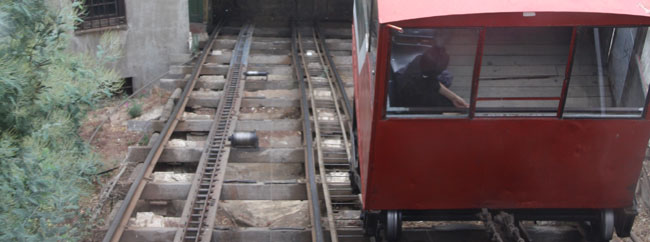
Valparaiso’s ascensores are facing an uphill struggle
10 September, 2011The city of Valparaiso is suffering a problem of identity. What to do when your trademark becomes unprofitable? Referred to as “The Jewel of the Pacific” much of Chile’s second city sits aside steep hills, offering stunning views stretching across valleys, down hills and out over the harbour into the Pacific.
Sitting alongside the hills, multi-coloured houses, and amazing graffiti the “ascensores” help to provide Valparaiso with its unique feel, its personal identity. Recently the system has become antiquated and expensive to repair and run. But with nothing to take their place local residents risk becoming isolated, literally stuck up a hill with no way down.
Funiculars began servicing the hills in 1883, with the original Ascensor Concepcion still in operation. However, there is a lack of coherent planning. Many of the remaining cable cars are privately owned, others are owned by co-operatives, some are public property. Non, are classed as public transport and so therefore do no qualify for government funding or subsidies.
Plans have been put forward for the regional government to purchase all of the remaining routes, but the proposals have been bogged down by larger funding problems affecting the Valparaiso region.
Some locals, known as “porteons”, have focused anger at the recent classification of the city’s Latin Quarter as an UNESCO world heritage site. The classification allowed the national government access to a $73 million loan to help preserve the area.
Used mainly to resurface and generally spruce up the flatland economic centre while ignoring residents living on the hills, critics argue the money would have been better spent funding transport links and helping to tackle some of the endemic problems in the city; such as the vast numbers of stray dogs which currently roam the streets. Commerce they argue could also do with boosting as the port of Valparaiso recently lost its standing as Chile’s largest commercial port (by tonnage).
This in some ways makes the promotion of tourism even more vital, and the cable cars are defiantly part of that. But they risk becoming a symbol of misguided funding if they fall into the sole use of tourists paying unrealistic sums for a short trip to see a view, pricing locals out of their use.
One cannot help but draw comparisons with many a European city who lost interest in their tram networks, ripping them out to make way for cars, now re-instating them at vast public expense.
While in Chile I visited Valparaiso and did indeed use one of the cable cars, for a short journey up a hill. Even during that briefest of experiences some of the problems were obvious. The mechanics are simply from another time, Dickensian almost. They also don’t leave until full. A simple enough proposition, but one that has the potential to keep you waiting, they don’t run to a timetable.
Those issues aside I wasn’t relishing walking up the cerro, and I’m relatively young, fit, and wasn’t carrying any shopping. The stairs rose high into the sky, uneven and daunting.
In a country so dominated by Santiago, regions outside capital battle to hold on to their individual identity. Valparaiso manages to create a one-off and it would be a shame if any of that were lost.
If these symbols of the city ever begin their final journeys Valparaiso will lose something much less tangible along with its obvious practicalities.
Here’s hoping their renaissance is just around the corner.
You can read further perspectives on Chile from Mark Briggs in a series of articles he wrote for Sounds and Colours called Santiago Days. Follow his Tweets at @briggsma.
Follow Sounds and Colours: Facebook / Twitter / Instagram / Mixcloud / Soundcloud / Bandcamp
Subscribe to the Sounds and Colours Newsletter for regular updates, news and competitions bringing the best of Latin American culture direct to your Inbox.

